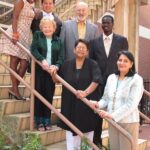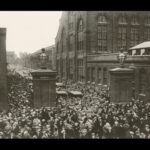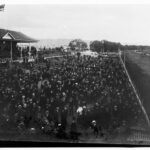When Australia’s first permanent European settlement was established in 1788, South Australia’s population is estimated to have been around 15 000. There is evidence that epidemic disease, introduced on the east coast by Europeans, reduced the Aboriginal population even before settlement of South Australia. Numbers only commenced growing again after 1921, not reaching pre-contact levels until 1991. As part of the discrimination suffered by Aboriginal South Australians, they were not included in census counts until 1966.
European population of South Australia
The continuous although fluctuating growth of South Australia’s European population from 1836 can be traced in head counts, successive five-yearly censuses from 1851 to 1881 (the first census taken simultaneously throughout Australia), then in 1891 and from 1911 in national Australian census counts. The amount of detail collected and still extant from each census varies considerably. The first enumeration was a ‘muster’ of 1841, by which time the colony’s European population was 14 610.
While censuses are the main sources of population information in South Australia, data on births and deaths collected by the Registrar of Births, Deaths and Marriages go back to 1846. Since that time the rate of fertility has undergone substantial changes. For much of the period South Australia’s fertility level has been lower than that in other colonies/states. Data on international migration to and from South Australia also extend back to the early years of the colony. Fluctuations in net inwards migration correlate with periods of prosperity and net losses with economic difficulty in the colony. Levels of interstate migration have also significantly affected the state’s population growth.
Diversity of European population
South Australia’s population has grown not only in size, but also in diversity. In 1881, although people of Anglo-Celtic origins dominated, South Australia was also home to significant numbers of people born elsewhere in Europe, especially Germany. By 1947, however, the predominance of the British Isles as a source of immigrants during the first half-century after Federation was reflected in the fact that 98.7 per cent of the population came from an English-speaking country. Thereafter the impact of the post-World War II immigration program saw their predominance considerably reduced. In 1996 three-quarters of the population were Australian born, 16.6 per cent originated in Europe, and 2.6 per cent from Asia. South Australia’s current demographic profile is the oldest of all Australia’s states and territories, with a median age of around 37 years and some 14.5 per cent of the population over the age of 65 years.
Distribution of population
Since the arrival of the Europeans, most South Australians have lived in Adelaide, but from the 1970s the capital’s share of the state’s population has tended to level off at just under 75 per cent. While smaller urban centres continue to grow, the state’s rural population has now fallen to under 14 per cent of the total.
Benefits of Census data
Census data, unlike many other sources of historical information, provide a snapshot of the entire population, not just the elite. South Australia’s demography is in many ways the most distinctive of all Australia’s states, but the wealth of historical population data available for both the colony and state remains under-analysed. This task will become easier when all extant census and other population data of the state is transferred into electronic form.







Comments